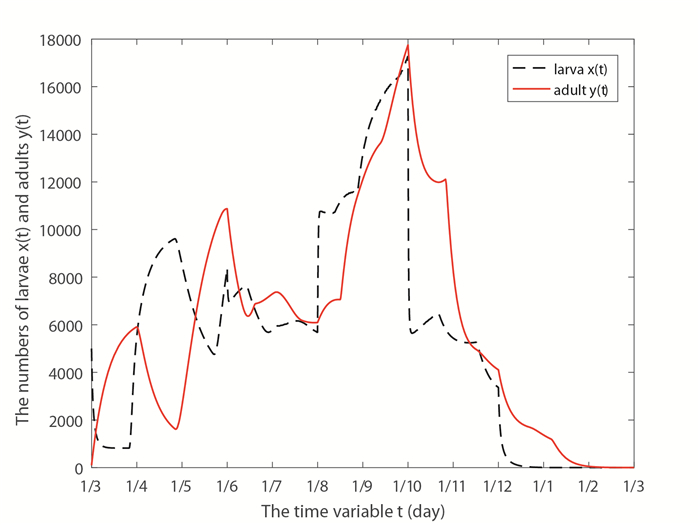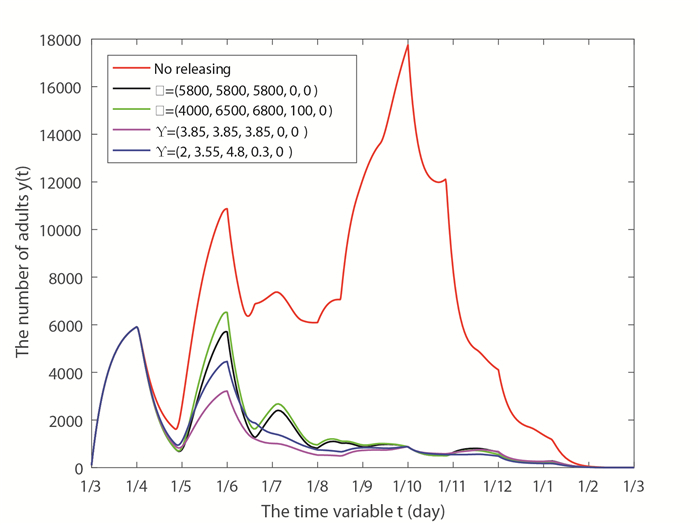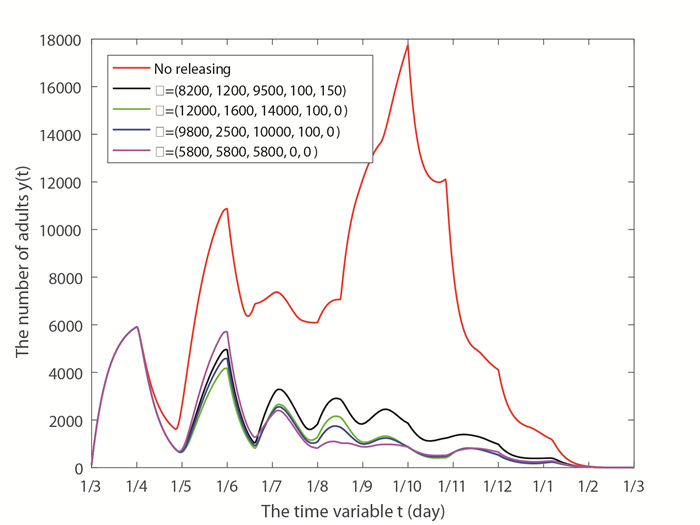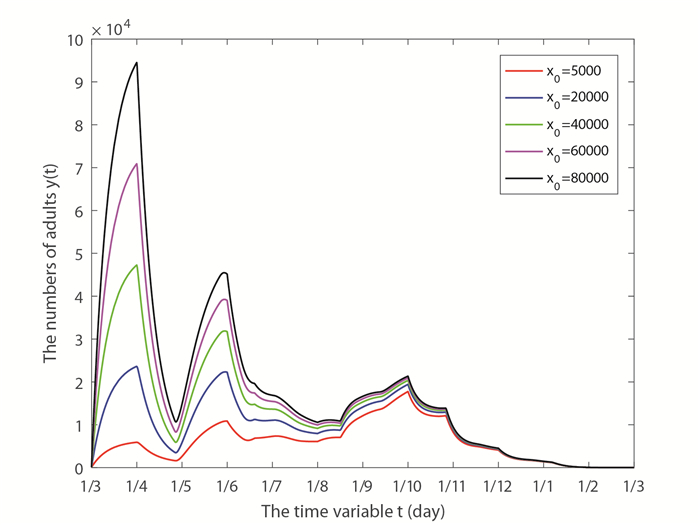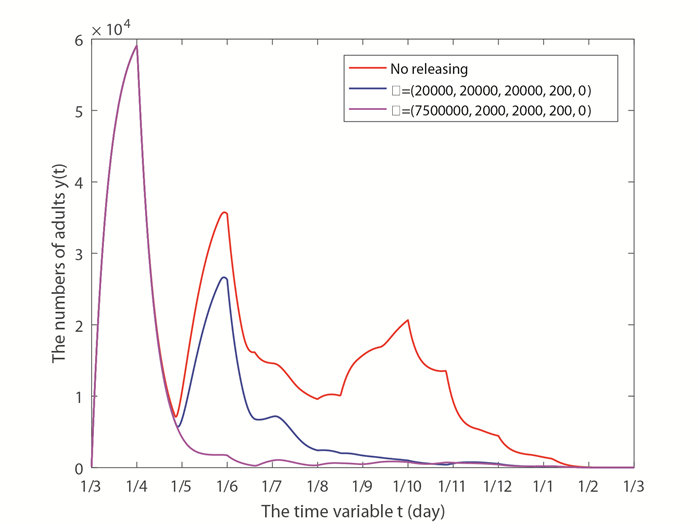|
[1]
|
S. Bhatt, P. W. Gething, O. J. Brady, J. P. Messina, A. W. Farlow, C. L. Moyes, J. M. Drake, J. S. Brownstein, A. G. Hoen, O. Sankoh, M. F. Myers, D. B. George, T. Jaenisch, G. R. W. Wint, C. P. Simmons, T. W. Scott, J. J. Farrar and S. I. Hay, The global distribution and burden of dengue, Nature, 2013, 496, 504-507
Google Scholar
|
|
[2]
|
E. Beretta and Y. Kuang, Geometric stability switch criteria in delay differential systems with delay dependent parameters, SIAM J. Math. Anal., 2002, 33, 1144-1165. doi: 10.1137/S0036141000376086
CrossRef Google Scholar
|
|
[3]
|
P. Cailly, A. Tran, T. Balenghien, G. L'Ambert, C. Toty and P. Ezanno, A climate driven abundance model to assess mosquito control strategies, Ecol. Model., 2012, 227, 7-17. doi: 10.1016/j.ecolmodel.2011.10.027
CrossRef Google Scholar
|
|
[4]
|
E. Caspari and G. S. Watson, On the evolutionary importance of cytoplasmic sterility in mosquitoes, Evolution, 1959, 13, 568-570. doi: 10.1111/evo.1959.13.issue-4
CrossRef Google Scholar
|
|
[5]
|
D. L. Denlinger and P. A. Armbruster, Mosquito diapause, Annu. Rev. Entomol., 2014, 59, 73-93. doi: 10.1146/annurev-ento-011613-162023
CrossRef Google Scholar
|
|
[6]
|
L. Gavotte, D. Mercer, R. Vandyke, J. W. Mains and S. L. Dobson, Wolbachia infection and resource competition effects on immature Aedes albopictus (Diptera: Culicidae), J. Med. Entomol., 2009, 46(3), 451-459. doi: 10.1603/033.046.0306
CrossRef Google Scholar
|
|
[7]
|
P. A. Hancock, V. L. White, A. G. Callahan, C. H. J. Godfray and A. A. Hoffmann, Density-dependent population dynamics in Aedes aegypti slow the spread of wMel Wolbachia, J. Appl. Ecol., 2016, 53, 785-793. doi: 10.1111/1365-2664.12620
CrossRef Google Scholar
|
|
[8]
|
L. Hu, M. Tang, Z. Wu, Z. Xi and J. Yu. The threshold infection level for Wolbachia invasion in random environments, J. Diff. Equ., 2019, 266(7): 4377-4393. doi: 10.1016/j.jde.2018.09.035
CrossRef Google Scholar
|
|
[9]
|
L. Hu, M. Huang, M. Tang, J. Yu and B. Zheng. Wolbachia spread dynamics in multi-regimes of environmental conditions, J. Theor. Biol., 2019, 462: 247-258. doi: 10.1016/j.jtbi.2018.11.009
CrossRef Google Scholar
|
|
[10]
|
L. Hu, M. Huang, M. Tang, J. Yu and B. Zheng, Wolbachia spread dynamics in stochastic environments, Theor. Popul. Biol., 2015, 106, 32-44. doi: 10.1016/j.tpb.2015.09.003
CrossRef Google Scholar
|
|
[11]
|
M. Huang, M. Tang and J. Yu, Wolbachia infection dynamics by reaction-diffusion equations, Sci. China Math., 2015, 58, 77-96.
Google Scholar
|
|
[12]
|
M. Huang, J. Yu, L. Hu and B. Zheng, Qualitative analysis for a Wolbachia infection model with diffusion, Sci. China Math., 2016, 59, 1249-1266. doi: 10.1007/s11425-016-5149-y
CrossRef Google Scholar
|
|
[13]
|
M. Huang, J. Lou, L. Hu, B. Zheng and J. Yu, Assessing the efficiency of Wolbachia driven Aedes mosquito suppression by delay differential equations, J. Theor. Biol., 2018, 440, 1-11. doi: 10.1016/j.jtbi.2017.12.012
CrossRef Google Scholar
|
|
[14]
|
M. J. Keeling, F. M. Jiggins and J. M. Read, The invasion and coexistence of competing Wolbachia strains, Heredity, 2003, 91, 382-388 doi: 10.1038/sj.hdy.6800343
CrossRef Google Scholar
|
|
[15]
|
Y. Li, F. Kamara, G. Zhou, S. Puthiyakunnon, C. Li, Y. Liu, Y. Zhou, G. Yan and X. Chen, Urbanization inreases Aedes albopictus larval habitats and accelerates mosquito development and survivorshop, PLoS Negl. Trop. Dis., 2014, 8(11), e3301. doi: 10.1371/journal.pntd.0003301
CrossRef Google Scholar
|
|
[16]
|
H. Lin, T. Liu, T. Song, L. Lin, J. Xiao, J. Lin, J. He, H. Zhong, W. Hu, A. Deng, Z. Peng, W. Ma and Y. Zhang, Community involvement in dengue outbreak control: An integrated rigorous intervention strategy, PLoS Negl. Trop. Dis., 2016, 10(8), e0004919. doi: 10.1371/journal.pntd.0004919
CrossRef Google Scholar
|
|
[17]
|
Z. Liu, Y. Zhang and Y. Yang, Population dynamics of Aedes (Stegomyia) albopictus (Skuse) under laboratory conditions, Acta Entomol. Sin., 1985, 28(3), 274-280.
Google Scholar
|
|
[18]
|
F. Liu, C. Zhou and P. Lin, Studies on the population ecology of Aedes albopictus 5. The seasonal abundance of natural population of Aedes albopictus in Guangzhou, Acta Sci. Natur. Universitatis Sunyatseni, 1990, 29(2), 118-122.
Google Scholar
|
|
[19]
|
F. Liu, C. Yao, P. Lin and C. Zhou, Studies on life table of the natural population of Aedes albopictus, Acta Sci. Natur. Universitatis Sunyatseni, 1992, 31(3), 84-93.
Google Scholar
|
|
[20]
|
R. A. Ross, N. M. Endersby, H. L. Yeap and A. A. Hoffmann, Larval competition extends developmental time and decreases adult size of wMelPop Wolbachia infected Aedes aegypti, Am. J. Trop. Hyg., 2014, 9(1), 198-205.
Google Scholar
|
|
[21]
|
H. L. Smith, An introduction to delay differential equations with applications to life sciences, Springer, New York, 2011.https://link.springer.com/book/10.1007%2F978-1-4419-7646-8
Google Scholar
|
|
[22]
|
A. Tran, G. L'Ambert, G. Lacour, M. Demarchi, M. Cros, P. Cailly, M. A. Kientz, T. Balenghien and P. Ezanno, A rainfall and temperature driven abundance model for Aedes albopictus populations, Int. J. Environ. Res. Public Health, 2013, 10, 1698-1719. doi: 10.3390/ijerph10051698
CrossRef Google Scholar
|
|
[23]
|
M. Turelli and A. A. Hoffmann, Rapid spread of an inherited incompatibility factor in California Drosophila, Nature, 1991, 353, 440-442. doi: 10.1038/353440a0
CrossRef Google Scholar
|
|
[24]
|
J. Waldock, N. L. Chandra, J. Lelieveld, Y. Proestos, E. Michael, G. Christophides and P. E. Parham, The role of environment variables on Aedes albopictus biology and Chikungunya epidemiology, Pathogens and Global Health., 2013, 107, 224-240. doi: 10.1179/2047773213Y.0000000100
CrossRef Google Scholar
|
|
[25]
|
R. K. Walsh, C. Bradley, C. S. Apperson and F. Gould, An experimental field study of delayed density dependence in natural populations of Aedes albopictus, PLoS One, 2012, 7, e35959. doi: 10.1371/journal.pone.0035959
CrossRef Google Scholar
|
|
[26]
|
R. K. Walsh, L. Facchinelli, J. M. Ramsey, J. G. Bond and F. Gould, Assessing the impact of density dependence in field populations of Aedes aegypti, J. Vect. Ecol., 2011, 36(2), 300-307. doi: 10.1111/jvec.2011.36.issue-2
CrossRef Google Scholar
|
|
[27]
|
E. Waltz, US reviews plan to infect mosquitoes with bacteria to stop disease, Nature, 2016, 89(1), 450-451.
Google Scholar
|
|
[28]
|
T. Walker, P. H. Johnson, L. A. Moreika, I. Iturbe-Ormaetxe, F. D. Frentiu, C. J. Mcmeniman, Y. S. Leong, Y. Dong, J. Axford, P. Kriesner, A. L. Lloyd, S. A. Ritchie, S. L. O'Neill and A. A. Hoffmann, The wMel Wolbachia strain blocks dengue and invades caged Aedes aegypti populations, Nature, 2011, 476, 450-453. doi: 10.1038/nature10355
CrossRef Google Scholar
|
|
[29]
|
WHO, Global strategy for dengue prevention and control 2012-2020, Geneva: World Health Organization, 2012.
Google Scholar
|
|
[30]
|
J. Wu, Z. Lun, A. A. James and X. Chen, Dengue fever in mainland China, Am. J. Trop. Med. Hyg., 2010, 83(3), 664-671. doi: 10.4269/ajtmh.2010.09-0755
CrossRef Google Scholar
|
|
[31]
|
Z. Xi, C. C. Khoo and S. L. Dobson, Wolbachia establishment and invasion in an Aedes aegypti laboratory population, Science, 2005, 310, 326-328. doi: 10.1126/science.1117607
CrossRef Google Scholar
|
|
[32]
|
J. Yu, Modeling mosqutio population suppression based on delay differential equations, SIAM J. Appl. Math., 2018, 78(6): 3168-3187. doi: 10.1137/18M1204917
CrossRef Google Scholar
|
|
[33]
|
B. Zheng, M. Tang and J. Yu, Modeling Wolbachia spread in mosquitoes through delay differential equation, SIAM J. Appl. Math., 2014, 74, 743-770. doi: 10.1137/13093354X
CrossRef Google Scholar
|
|
[34]
|
B. Zheng, M. Tang, J. Yu and J. Qiu, Wolbachia spreading dynamics in mosquitoes with imperfect maternal transmission, J. Math. Biol. 2018, 76: 235-263. doi: 10.1007/s00285-017-1142-5
CrossRef Google Scholar
|
|
[35]
|
B. Zheng, J. Yu, Z. Xi and M. Tang, The annual abundance of dengue and Zika vector Aedes albopictus and its stubbornness to suppression, Ecol. Model., 2018, 387: 38-48. doi: 10.1016/j.ecolmodel.2018.09.004
CrossRef Google Scholar
|
|
[36]
|
Z. Zhong and G. He, The life table of laboratory Aedes albopictus under various temperatures, Academic J. Sun Yat-sen University of Medical Sciences, 1988, 9(3), 35-39.
Google Scholar
|
|
[37]
|
Z. Zhong and G. He, The life and fertility table of Aedes albopictus under different temperatures, Acta Entom. Sinica, 1990, 33(1), 64-70.
Google Scholar
|




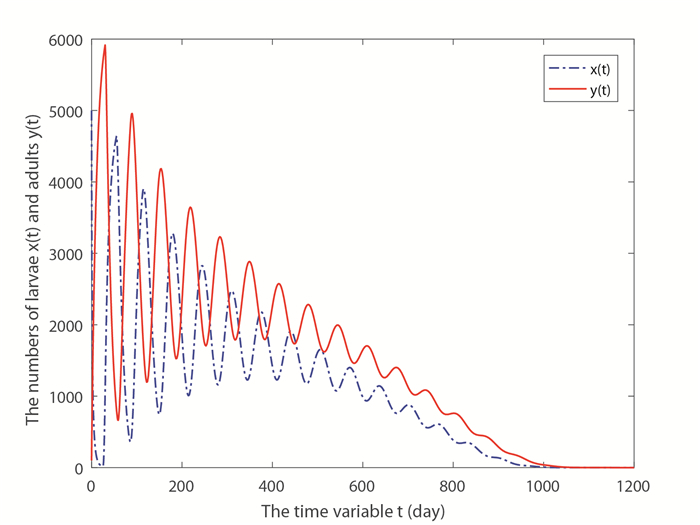

 DownLoad:
DownLoad:
